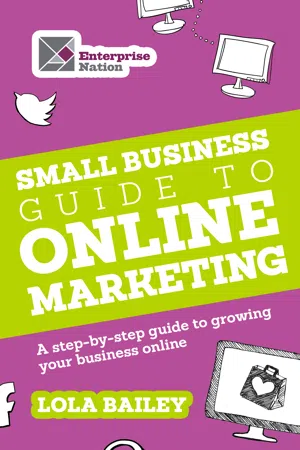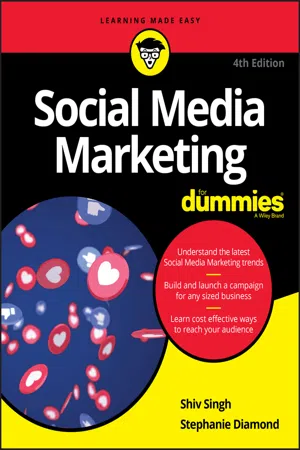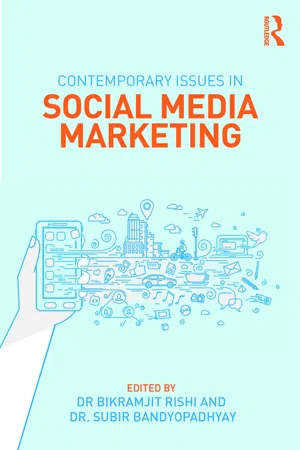Social Media Marketing
Social media marketing involves using social media platforms to connect with your audience to build your brand, increase sales, and drive website traffic. This involves creating and sharing content on social media networks, engaging with followers, and running social media advertisements. The goal is to reach and engage with potential customers where they are already spending their time.
7 Key excerpts on "Social Media Marketing"
- eBook - ePub
The Small Business Guide to Online Marketing
A step-by-step guide to growing your business online
- Lola Bailey(Author)
- 2012(Publication Date)
- Harriman House(Publisher)
...They are seen by people as being less biased than traditional advertising and it is for this reason that social media is so popular with marketers. Social media will facilitate: Conversations with your customers. You can use platforms such as blogs and social networking sites to share product details, list benefits, announce promotions, etc. With social media you can present a message to a very targeted demographic and see if your message resonates with your customers enough for you to use it as your primary medium of marketing. For example, if your product or service is targeted at young customers, you could try Facebook which is very popular with younger age groups. Your customers talking to one another. Social media allow one person to communicate with tens of thousands of people about products and services, instantly. This is described as ‘going viral’. To be successful it is important for you to learn not only where and how your customers gather information, but also how you can leverage the conversations about your brand that are being had. How? By joining in! What is Social Media Marketing? Internet marketing authority David Meerman’s explanation of Social Media Marketing is one of the most accessible I have come across: You can buy attention (advertising). You can beg for attention from the media (PR). You can bug people one-at-a-time to get attention (sales). Or you can earn attention by creating something entertaining and useful for others and then publishing it online for free: a YouTube video, a blog, a research report, photos, an eBook or a Facebook page (Social Media Marketing). The platforms you use should reflect where your customers “hang out”, although as already mentioned, there are some benefits in being on multiple channels. Each platform also brings its own characteristics, for example: Currently on Facebook the largest demographic group is the female, 18-25 age group – but the average age on Facebook is 38...
- eBook - ePub
- Shiv Singh, Stephanie Diamond(Authors)
- 2020(Publication Date)
- For Dummies(Publisher)
...With over 300 million people using the web on a regular basis in the United States alone and approximately 3.2 billion users globally, using the Internet has become a mainstream social activity. Consumers approach purchasing online differently, too, and as a result, you need to approach your marketing online differently as well. Your approach must incorporate influence and the different roles that people play in the realm of social media, especially because social media itself has changed over the last decade with the rise of smartphones. This chapter discusses the fundamentals of Social Media Marketing: what it is, how it works, who the players are, and what it means in the context of your other marketing efforts. Defining Social Media Marketing A discussion of any subject needs to begin with a definition, and so here’s the one for Social Media Marketing: Social Media Marketing (SMM) is a technique that employs social media (content created by everyday people using highly accessible and scalable technologies such as social networks, blogs, micro-blogs, message boards, podcasts, social bookmarks, communities, wikis, and vlogs). Social media (which has probably been one of the most hyped buzzwords of the last decade) refers to content created and consumed by regular people for each other. It includes the comments a person adds at the end of an article on a website, the family photographs she uploads to a photo-sharing service, the conversations she has with friends in a social network, and the blog posts she publishes or comments on. That’s all social media, and it’s making everyone in the world a content publisher and arbitrator of content. It’s democratizing the web. Facebook, shown in Figure 1-1, is the most popular social network. It allows you to connect with friends and share information in a matter of minutes...
- eBook - ePub
- Jochen Strähle, Jochen Strähle(Authors)
- 2015(Publication Date)
- Books on Demand(Publisher)
...190). Figure 3 shows one finding of Wave 7, which was first published in 2013. More than one billion Internet users from 72 countries participated. The finding confirms an issue that we all quite knew already: the smartphone has become “an ever present companion” with all different types of media (Parker, 2013, p. 29). This means, that companies must be aware about the fact that social media is used everywhere at every time and that consumers expect companies to be up to date. Since a customer is far more worth than his pure purchases and social media can have an impact on future spending, a detailed strategy is needed (Fisher, 2009, p. 190). The use of social media can furthermore build a bridge between consumers and a company, meaning that if properly done, the possibility to get closer to a firm’s customers will be improved. This can facilitate increased revenues, efficiencies and cost reductions (Heller Baird & Parasnis, 2011, p. 30). Social Media Marketing is therefore the most significant part of digital marketing to acquire new customers and establish a long-term relationship with existing customers. An approach on how to establish a sufficient social media strategy will be introduced later in this chapter. Figure 23: “Thinking about devices, do you ever use them whilst consuming…?” Adapted from: (Parker, 2013, p. 29) 2.4.1 Definition Social media mainly consists of conversations between consumers. Integrated technology helps users to share pictures, audios and videos on various platforms that are diversely designed. By doing so, social interaction can be established and shared meanings in communities build (Hettler, 2010, p. 14). Since conversations often take place without the interaction of a company, a marketing approach is needed. Social Media Marketing aims at “monitoring and facilitating customer-customer interaction and participation throughout the web to encourage positive engagement with a company and its brands” (Chaffey & Ellis-Chadwick, 2012, p...
- eBook - ePub
Digital Marketing in the Zone
The Ultimate System for Digital Marketing Success
- David Reske(Author)
- 2017(Publication Date)
- Morgan James Publishing(Publisher)
...Social Media Marketing in the Zone Social Media Marketing Strategy S ocial media marketing has become one of the most important marketing techniques. Facebook now has over 1.7 billion users, Instagram has 400 million, Twitter has 320 million, and LinkedIn has 100 million members. 16 There are over 2.2 billion active social media users worldwide 17. Social media traffic has accounted for almost all Internet traffic growth in the past five years. As newspaper readers and TV viewers decline, social media usage continues to grow rapidly. Today, 65% of the United States’ online adults use social media—a nearly 10-fold jump in the last 10 years. 18 With so many users on social media sites, there’s no question that your target audience is using social media. Social media can be a very powerful tool for every organization, from the very large to the very small. It lets you drive more traffic to your website, and engage with your customers and prospects in a more personal and powerful way. Because of all of this, Social Media Marketing should be part of every high-performance marketer’s toolkit. Amy’s Social Media Marketing Program Amy was the Director of Corporate Communications at a division of a large telecommunications company. Her division used many traditional marketing vehicles including PR, analyst relations, events, and brand advertising to reach their target audience and drive leads. While she was very professional in all of her work, she was uneasy with the fact that few of these programs produced any measurable results. She wanted to get more engagement through social media platforms, but the social media team at her HQ kept a tight rein on their social media programs, so very little of her content made it into their channels. We got involved with Amy and built new social media channels for her division including Facebook, Twitter, and Linkedln properties...
- eBook - ePub
Social Media Communication
Concepts, Practices, Data, Law and Ethics
- Jeremy Harris Lipschultz(Author)
- 2020(Publication Date)
- Routledge(Publisher)
...1). While it may be useful for a content manager to use Hootsuite or another management tool to organize social media conversations, it is crucial to recognize what is being said within a particular platform at a given time. Online engagement translates to conversation that is aware of what is happening within the culture – from Super Bowl chatter to a storm response. A social media brand manager understands her or his personal brand, company brands, and those of others. Consistent and sensitive messages help build online trust over time, which may be leveraged in the future. Social Media Strategic Planning, Awareness, and Engagement One important distinction between social networking site activity and social media is the role of social business models. Cha (2013) identified value creation, sources of competency, target market, and revenue as four business considerations. Value is theoretically created through successful brand positioning within the market, but branding also is considered a specific competency (p. 63). Social media engagement is created through positive interaction within a specific social media online space. For example, Twitter’s real-time information positioning is different from LinkedIn’s professional and job seeker target market, which typically is not as connected to a moment in time (p. 76). It is important within advertising and marketing perspectives for a team to develop social media plans that guide responses during a crisis, but also direct the general purposes and goals of ongoing engagement. Increasingly, teams employ an integrated media approach that weds PR, advertising, marketing, and general business plans. Social media sites are noisy, and it is not easy to reach consumers and make them aware of current branding...
- eBook - ePub
Introduction to Digital Marketing 101
Easy to Learn and implement hands on guide for Digital Marketing
- Cecilia Figueroa(Author)
- 2019(Publication Date)
- BPB Publications(Publisher)
...Digital media have their advantages and can be a combination of media, but they are probably, from many points of view, secondary and complementary. In fact, it can be argued that the dominance of traditional media, especially television, radio, and outdoor advertising (it is a strategy much easier to carry and find, since a target audience is differentiated), has led to the aggressive search for new media and their effective understanding to optimize results. On social media, people are committed to have space and constant interactions and the message gains more credibility because the speaker is most likely an acquaintance in whom we trust. However, that is not the case with advertising where the company has an interest in making you buy your product. On social networks, you can see someone making a recommendation, usually without any commitment to the company. It is word of mouth in expanded proportions. For example, it is easy to see what people think about brands and products on Twitter. The decision to be on social networks is independent of the company: people decide if they are going to talk about it and whether they will speak well or badly. However, a company that considers results in digital marketing as important must optimize its presence on the Internet. The role of marketing is to understand and serve the market. Social networks enhance the capacity of any business to better understand the needs of its customers. Thus, technology gives a new power to advertising that translates into offering the consumer not only communication but experiences that raises the relationship between both players to another level. This has been demonstrated by a number of brands worldwide; here is one example: Apple: “Don’t mess with Mother,” an iPhone campaign, is an example of humanizing technology...
- eBook - ePub
- Bikramjit Rishi, Subir Bandyopadhyay(Authors)
- 2017(Publication Date)
- Routledge(Publisher)
...4 Social Media Marketing FOR B2B From information to decision to retention Roisin Vize and Monique Sherrett Introduction Social networks in a business context are referred to as two or more connected business relationships, where an ‘exchange’ exists between business partners. The concept of a ‘network’ is based on the establishment of ties between individuals, groups of people, organizational departments or corporations that lead to the creation of social networks (Michaelidou et al. 2011: 1,154). Advances in web-based technology and innovation have changed the nature of social networks. Where traditional social networks involve personal and social interaction between people, these interactions are now mediated by computers and web-connected devices such as mobile phones, laptops and e-notebooks. Social Media Marketing has fundamentally changed the way marketers communicate, interact, consume and create, both within and outside the firm. This form of marketing represents one of the most transformative impacts web technology has had on companies since the advent of the Internet (Dou et al. 2013). The growth of social media sites has revolutionized the way businesses relate to the marketplace, opening up new and exciting possibilities but also creating unprecedented challenges (Aral 2011; Kaplan and Haenlein 2010). As Social Media Marketing has proliferated significantly from a B2C context, its uptake as a marketing tool in the B2B context is relatively meagre by comparison (Swani et al. 2014). This chapter explores the benefits and challenges of Social Media Marketing from a B2B perspective. It synthesizes theoretical and practitioner frameworks for understanding and resolving challenges relating to social media strategy development, tactical implementation and performance measurement...






